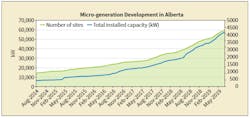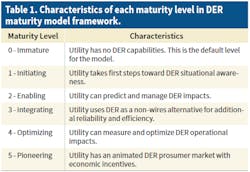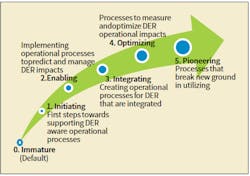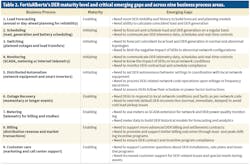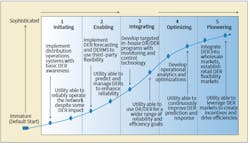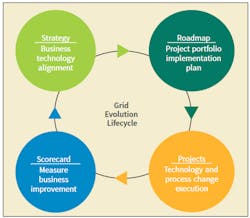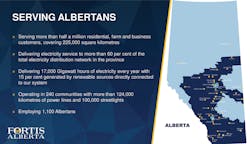FortisAlberta's 2030 Roadmap to Modernize
With more than 250,000 sq miles (660,000 sq km) of mountains, prairies, forests, lakes and glaciers, the province of Alberta, Canada, is blessed with rich mineral and energy deposits, making it one of the world’s largest producers of oil and natural gas. To diversify its economy and protect its environment, Alberta adopted a climate leadership plan to reduce greenhouse gas emissions, end pollution from coal-generated electricity and increase renewable generation to 30% by 2030. A modern grid capable of supporting a high penetration of renewables is critical to realizing this clean energy vision.
FortisAlberta Inc. is responsible for more than 60% of Alberta’s vast electric distribution network, supplying power to 553,000 residential, farm and business customers across 240 central and southern province communities. Currently, renewables and microgeneration account for about 15% of Alberta’s generation portfolio.
With more than 80 large renewable projects in the development queue, FortisAlberta Inc. will add 2 GW of new distributed generating capacity in the next three years. Even before increasing its capacity, the electric utility has been experiencing operational issues trying to manage power balance and power quality in areas with high penetrations of distributed energy resources (DERs) connected to its distribution network. Ultimately, the utility needed a roadmap to pave the way toward a clean energy future.
The DER Challenge
In 2016, FortisAlberta began to address its growing DER challenge by designing and implementing a grid modernization program. The early focus of the program was on improving grid situational awareness through increased field automation, advanced metering and telecommunications. Projects included the implementation of a new meter data management system and corporate-wide radio frequency mesh network. The utility also began deploying fault location, isolation and service restoration equipment in the field to create self-healing networks on the more populated substations.
By 2018, FortisAlberta started looking toward becoming more proactive in avoiding potential grid reliability and quality issues while integrating higher levels of renewables onto the distribution network.
The FortisAlberta engineering team approached CEATI International Inc., the Center for Energy Advancement through Technological Innovation, for assistance. This was a logical action as FortisAlberta is a member of the CEATI smart grid group. CEATI identified an opportunity to create a DER operations roadmap specifically to improve its DER-related processes and systems. Together, FortisAlberta and CEATI selected GridBright Inc. to develop a case study for the utility participants. Numerous electric utility members of the CEATI smart grid program contributed to and shared the results of this project.
Operational Maturity
The first step of the process was to understand the current state of DER operations in FortisAlberta. The team used a DER maturity model framework developed by GridBright and CEATI. The framework identifies the types of issues grid operators face as DER volumes grow and outlines realistic steps for incremental modernization as new challenges or opportunities arise.
The framework is organized by the typical evolutionary stages of DER-related operations.
Applying this DER maturity model framework as a guide, the team conducted a deep dive into FortisAlberta’s current situation. Control staff operators reported observing some voltage problems where large DERs had been installed that occasionally resulted in automated protection disconnections. It also was reported that most small DERs were not telemetered, resulting in operational blind spots.
The largest DERs have supervisory control and data acquisition (SCADA) telemetry on the overhead line recloser at the point of interconnection, whereas the smaller behind-the-meter generation is hidden in the net load telemetry only seen at the low-voltage (LV) feeder level. All renewables and DERs are essentially non-load dispatchable generating facilities, so they are excluded from contingency operating plans.
During network maintenance or other abnormal network configurations, large DERs are manually disconnected through SCADA controlled reclosers to avoid islanding and other unanticipated net loading effects. During outage events, DERs operate as per-network interconnection codes and autonomously go off-line, resulting in a black-start load pickup problem during recovery.
Overall, the GridBright team assessed that FortisAlberta was positioned between the initiating and enabling levels of the DER maturity model. On one hand, the utility had situational awareness of large DERs through SCADA, so it could operate the network reliably despite pockets of localized network load congestion and the occasional impact of DER. On the other hand, the utility could not predict DER-driven power balance or quality issue, which meant it did not have the ability to dispatch DERs to avoid reliability issues.
Currently, there is no requirement or urgent need for any demand-side management programs with generators for customers. However, FortisAlberta wants to use the DER flexibility as a non-wires alternative for additional hosting capacity, network reliability and operating efficiency.
Modernization Goals
The DER maturity model provides suggested roadmaps for six major grid operations subprocesses, including load forecasting, scheduling, switching, monitoring, distributed automation and outage recovery.
The FortisAlberta team evaluated an expanded set of nine critical business process areas that would be negatively impacted by DER penetration growth. The scope included both operations and additional supporting processes, such as metering, billing and customer care. For each business process, FortisAlberta identified the current level of maturity and critical emerging gaps.
The Roadmap
FortisAlberta is faced with a significant business risk in how quickly it needs to invest to address the identified gaps in its various business processes, given the regional uncertainty about the relative pace of growth from industrial, residential, and community choice aggregation segments. It also is difficult to predict and plan a roadmap when evolving regulatory mandates or clean energy incentive programs can cause a rapid shift in DER penetration rates and types.
Therefore, the team examined three potential regional scenarios, which would accelerate the need for operational changes:
- A continued trend of new large DER interconnection requests, with large being defined as those with 15 MW in generating capacity.
- A dramatic increase in small DERs, with small being defined as those < 20 kW in capacity.
- A rapid increase in community aggregates of load or DERs within the service area.
For each scenario, FortisAlberta identified the most urgent gaps to be addressed through short-term and long-term technology projects. It found some technology projects were required regardless of the scenario and could be considered no-regrets investments. This meant the project provided immediate value, and there were no concerns the technology investment might be wasted if DER trends changed rapidly.
Designing an Effective Roadmap
A good technology project roadmap is realistic and defensible in front of regulators, stakeholders and business management. It defines how a utility will address the technology, processes and organization of future operations. Regardless of where a utility starts on its grid modernization journey, the roadmap should provide clear and justifiable answers to critical questions:
- What systems, processes and data are required to realize the modernization strategy?
- What technology options are available and how will they integrate with a legacy environment?
- What integration and cybersecurity architectures are needed?
- What change management, training and process changes are required for operations?
- How will legacy systems, processes and data need to be prepared?
- How will risks and uncertainties be mitigated?
Recommendations
The team developed and recommended a roadmap focused heavily on pragmatic no-regrets technology projects that provide incremental benefits in the short term while preparing the utility for an uncertain future. The recommendations ranged from simple technology upgrades to more dramatic system architecture and work process changes that would support dramatically higher DER penetration rates. The first set of projects included some immediate efforts to enhance the FortisAlberta metering infrastructure, historical data repositories, forecasting systems and grid planning tools.
These will be followed in the longer term by a search for an advanced distribution management system to improve local congestion visibility and control. A distributed energy resource management system could optionally be accelerated if the utility experiences a rapid increase in small DERs or decides to create DER flexibility programs as a non-wires alternative approach to increasing its hosting capacity.
Full Speed Ahead
The methodology developed and implanted by GridBright and CEATI enables FortisAlberta to understand the extent of the operational impacts that can be expected as volume of DER increases. The utility spends more than CDN$400 million annually on distribution network capital projects. The roadmap provides clarity on where there is a need to invest in technology and improve processes to be ready for the coming challenges. It is a vital part of the grid evolution cycle of continuous strategic adjustments to stay current with regional energy demands.
Since every region is different, utilities will need conduct their own assessment and build their own custom roadmaps based on their own current situation, DER growth challenges, regulatory drivers and business aspirations.
For more information:
CEATI International Inc. | www.ceati.com
GridBright Inc. | www.gridbright.com
About the Author
Grant Wiens
Grant Wiens is the manager engineering at FortisAlberta Inc., where he is responsible for SCADA, power quality, protection and control, and standards. He has more than 25 years of industrial experience, including electrical distribution, natural gas distribution, pharmaceuticals and brewery operations.
Travis Rouillard
Travis Rouillard is the CTO of GridBright Inc., where he is responsible for technology direction, innovation, and development. He has more than 20 years of experience building and deploying utility software solutions, especially in the areas of demand response and distributed energy resource (DER) management. Rouillard regularly teaches courses on grid modernization for DISTRIBUTECH International, EUCI, and utility clients.
Alex Mogilevsky
Alex Mogilevsky is the director, transmission and distribution (T&D), at CEATI International Inc., where he is responsible for 10 international T&D programs for electrical utilities. He has more than 30 years of management experience, including electrical distribution and transmission, research and development, and technology transfer.

